
[elfsight_social_share_buttons id=”1″]
Emergency officials in California’s San Luis Obispo County spent early Friday patrolling levies and swollen rivers after an atmospheric river storm drenched the already-saturated state with torrential rain, raising the flooding risk in some areas.
As much as 5 inches of rain has already fallen in some spots across the county, with some seeing as much as 7 inches. In higher elevations of the coastal county, which sits roughly midway between Los Angeles and San Francisco, as much as 15 inches of rain may fall, the National Weather Service said as it issued a flash flood warning.
President Joe Biden on Friday declared an emergency in California, ordering federal assistance to help local, tribal, and state officials respond to the severe weather.
Emergency crews have spent the last day preparing for the possibility of dangerous flooding, monitoring levies, creeks, and rivers, and filling sandbags, said Rachel Monte Dion, the county’s emergency services coordinator.
Some personnel spent the night in trailers watching for flooding in low-lying areas across the county, which was hit hard by heavy downpours in January, causing a levy to fail and damaging homes.
“We’re very concerned. Since January, it’s been raining steadily here and so our ground is fully saturated and our creeks are full,” Dion said, noting that more than 1,200 residents were under evacuation orders and warnings.
“We are all on edge, expecting a very busy day today,” she said.
The heavy rains in northern and central California raised concerns that melting snow from a spate of blizzards in mid-elevation mountains could add to runoff and cause flooding downstream.
Gusty winds accompanying the showers are also expected to uproot trees loosely anchored in rain-soaked soils.
The storm is the product of what meteorologists call an atmospheric river, a high-altitude current of dense, subtropical moisture streaming into the West Coast from the warm Pacific waters around Hawaii.
It marks the latest of 10 such California storms since Christmas, adding to an exceptionally wet, snowy winter in a state that in recent years has been plagued far more by drought and wildfires than by severe precipitation.
In Santa Cruz County, officials overnight issued evacuation orders, telling residents living near rivers to move to higher ground as the National Weather Service issued a flash flood warning for that area.
Six inches of rain were expected to fall in the area, causing parts of the rapidly rising San Lorenzo River to reach a major flood stage of 22 feet and cause “life-threatening” flash flooding, the service said.
Waterfront communities along several major rivers and their tributaries across the state also braced for the possibility of overflowing streams swollen by heavy showers and runoff of melting snow.
On Friday morning, the weather service issued a flash flood warning for parts of Tulare County, including the small community of Springville, where the sheriff earlier this week issued an evacuation warning for homes and businesses along a stretch of the Kings River, which drains the Sierra Nevada mountain range.
“Move to higher ground now! This is an extremely dangerous and life-threatening situation,” it said in an advisory.
Copyright 2023 Thomson/Reuters
